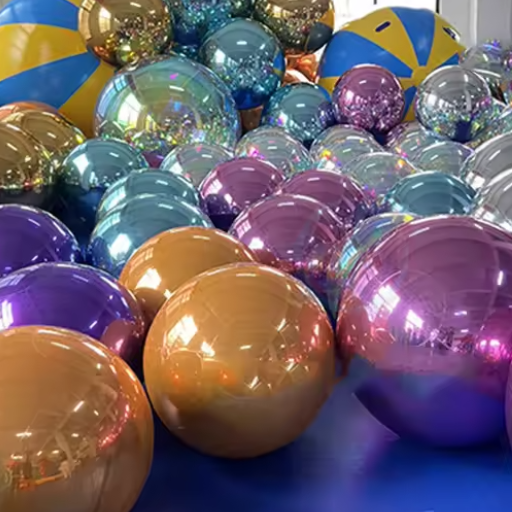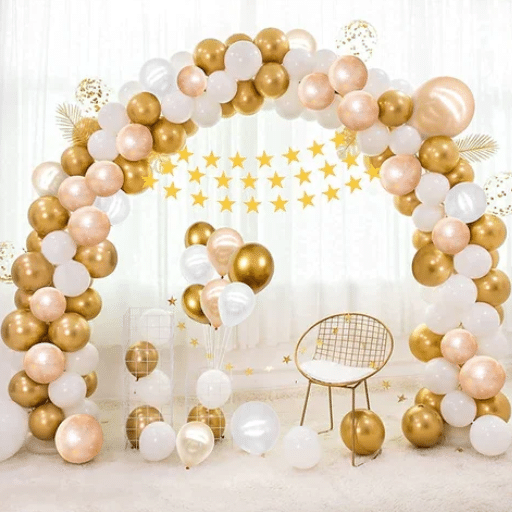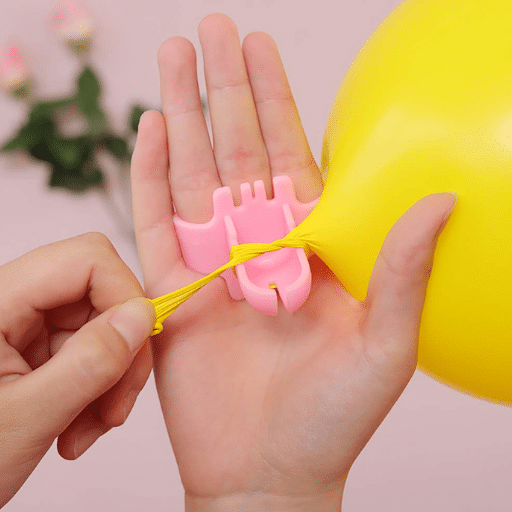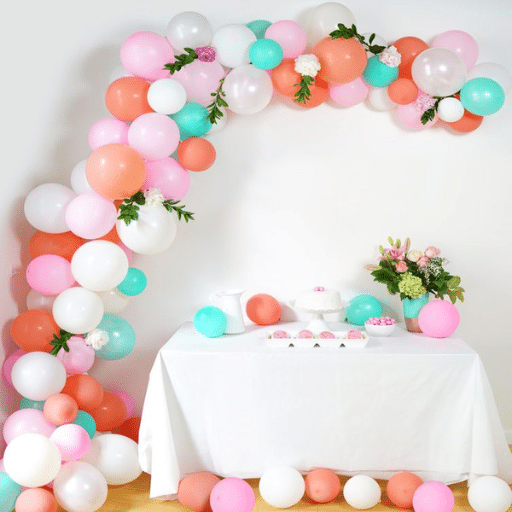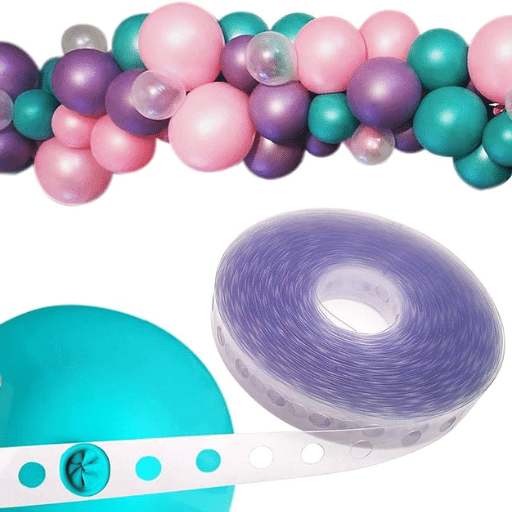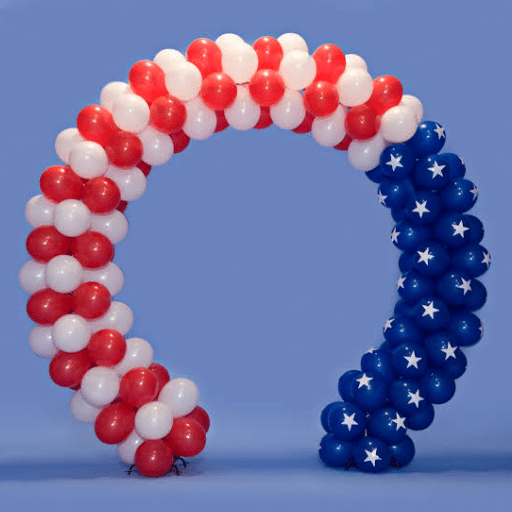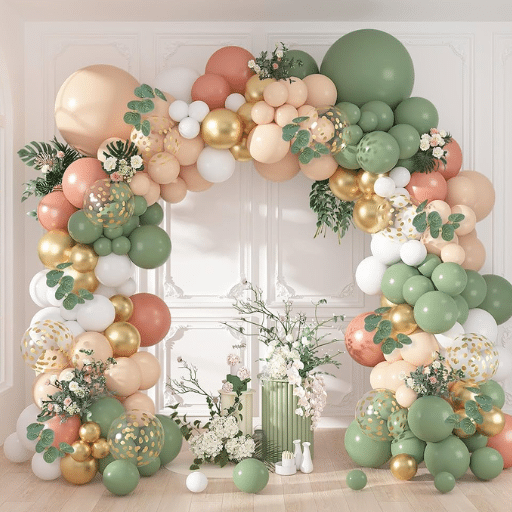Balloons remain the number one option for adding charm and festivity to any celebration for event planners and party lovers. But they are not all the same. Two of the most popular types, Mylar and latex balloons, bring unique characteristics and advantages. Most people choose between these options based on durability, aesthetics, environmental impact, and cost. In this guide, we’ll discover the primary differences between Mylar and latex balloons so that you can make the right choice for your next event. Be it a casual birthday celebration or an extravagant wedding, knowing these differences will aid you in designing the right atmosphere for your guests.
What Are the Main Types of Balloons?

Balloons are among the most popular accessories for events and celebrations worldwide. They are primarily classified into 2 types:
- Latex Balloons
Latex balloons are made from natural rubber, which can easily biodegrade. They are available in different colors, shapes, and sizes. Are you throwing a party? Latex balloons can easily fit all your needs since they are versatile and affordable. They can be inflated using both air and helium. However, latex balloons tend to float for a shorter duration when filled with helium compared to other types.
- Mylar Balloons
Foil balloons, often called Mylar balloons, are made with a special metallic plastic-coated material. Compared to latex balloons, Mylar balloons are more durable and can hold helium for longer. With bold, intricate designs, Mylar balloons are perfect for embellishments, helping to create astounding views.
Understanding Latex Balloons
Though only latex balloons are biodegradable, they are still the most popular choice for decoration. This is most likely due to their low cost, variety of options, and environmental benefits. Latex balloons come in a wide variety of colors, sizes, and shapes, and can be filled with either air or helium.
Grounded Mylar balloons generally hang suspended for longer than helium-filled latex balloons. Recent studies suggest that helium-filled latex balloons float for 12 to 24 hours, depending on the weather conditions and quality of the balloon itself. If prefilled latex balloons with helium are not floating for the expected amount of time, using Hi-Float could help. Hi-Float acts as a seal on the inside of the balloon, which prevents helium loss.
At the front, Hi-float may seem like a magic cure, but it does have opposing sides. For starters, balloons made from latex require special concern. Reports suggest that 1-6 percent of the population is affected by latex allergies, exposing sensitive individuals to alternative materials such as Mylar balloons. Additionally, the latex industry advocates for more responsible helium balloon disposal, claiming there is always a risk to the environment if balloons are not disposed of properly.
When organizing an event, pair colorful latex balloons with accessories like string or balloon weights to help alleviate littering concerns. Latitude in use, along with proper disposal, will allow balloons to elevate any celebration without adding strain to the environment.
An Overview of Mylar Balloons
Mylar balloons, or foil balloons, as they’re also called, are created from a thin layer of metalized plastic that gives the balloon a reflective and shiny surface, as well as a longer lifespan when compared to latex balloons. These balloons have become quite popular due to their vibrant colors and ability to hold helium for a long duration. However, unlike latex balloons, Mylar balloons are non-biodegradable, therefore proper disposal becomes essential to mitigate the environmental impact.
Here are five things that you did not know about Mylar balloons:
- Material Composition
Mylar balloons are made of polyester films that are covered in aluminum. This gives them their glossy look while simultaneously making them resistant to leaking air.
- Durability
Mylar balloons can retain helium for a couple of weeks by relying on the seal and the environment. Their strength also makes them less prone to popping and more enduring than latex balloons.
- Design Varieties
These balloons, in custom shapes and designs, are readily available for purchase for any event, making them perfect for themed parties or personalized celebrations.
- Environmental Impact
Even though they last longer, Mylar balloons are not biodegradable. Without any precaution, throwing them away for good can cause littering and great damage to nature.
- Safety Considerations
Mylar balloons can conduct electricity, which makes them a hazard near power lines due to potential outages and safety concerns.
When choosing Mylar balloons, consider combining aesthetic appeal, functionality, and environmental sustainability to make celebrations thoughtful and memorable.
Comparing Foil and Latex Balloons
| Parameter | Foil Balloons | Latex Balloons |
|---|---|---|
|
Material |
Mylar (metallic-coated plastic) |
Natural rubber latex |
|
Longevity |
1–3 weeks |
12–24 hours |
|
Cost |
More expensive |
Budget-friendly |
|
Appearance |
Shiny, metallic finish |
Matte, vibrant colors |
|
Shapes |
Wide variety (letters, characters, etc.) |
Mostly round, some specialty shapes |
|
Helium Retention |
Retains helium longer |
Loses helium quickly |
|
Durability |
Less prone to popping |
Easily pops |
|
Eco-Friendliness |
Non-biodegradable |
Biodegradable |
|
Customization |
Highly customizable designs |
Limited customization |
|
Best Use |
Long events, formal settings |
Short events, casual settings |
How Do Latex and Mylar Balloons Differ?

Both latex and mylar balloons are different in materials, durability, and environmental effects. While latex balloons come from natural rubber and are biodegradable (eventually), they stretch, which means they are suited for short-term use. Mylar balloons are made from a polyester film with a metallic coating, which not only makes these balloons last longer but also makes them more durable. On the downside, mylar balloons require proper disposal, are not biodegradable, and harm the environment without proper disposal. Each type of balloon serves different purposes, with latex ideal for colorful short-term decorations. In contrast, Mylar balloons are used when a polished look is needed and when longer float time is essential.
Material Composition: Latex Rubber vs. Polyester
| Parameter | Latex Rubber | Polyester (Mylar) |
|---|---|---|
|
Material Source |
Natural rubber from trees |
Synthetic metallic-coated polyester |
|
Biodegradability |
Biodegradable |
Non-biodegradable |
|
Durability |
Prone to popping |
More durable |
|
Appearance |
Matte or vibrant colors |
Shiny, metallic finish |
|
Customization |
Easy to print designs |
Highly customizable |
|
Helium Retention |
Short duration (12–24 hours) |
Long duration (up to weeks) |
|
Cost |
Affordable |
More expensive |
|
Eco-Friendliness |
Environmentally friendly |
Less eco-friendly |
|
Best Use |
Casual, short-term events |
Formal, long-lasting events |
Float Time: Which Balloons Last Longer?
Due to the composition of its materials, Mylar balloons float longer than latex balloons. Under the right temperature and humid conditions, latex balloons will float for approximately one to two days. On the other hand, mylar balloons can float for as long as one to five days or even weeks if conditions are perfect.
This difference can be attributed to their material composition. Latex rubber has tiny pores that cause helium to escape rapidly. Mylar balloons, on the other hand, have a polyester layer that acts as a barrier and reduces helium loss. Hi-Float treatments for latex balloons can extend float time, sometimes up to a few days, down to an internal seal that slows helium from leaking out.
An untreated 11-inch latex balloon loses helium, while a Mylar balloon of the same dimensions will still float. A Mylar balloon, on the other hand, is an 18-inch Mylar balloon that statistically lasts up to 7 days while latex balloons deflate within a single day. This is why Mylar balloons are preferred as decorations. However, unlike latex balloons, which are ideal for short-term biodegradable events, Mylar balloons do not biodegrade.
Environmental Impact: Biodegradable vs. Non-biodegradable
From an environmentally friendly point of view, I believe that latex biodegradable balloons are preferable to the rest. Latex balloons naturally decompose over time, thus minimizing pollution and the contribution of balloons. On the other hand, Mylar nonbiodegradable balloons will increase pollution and endanger wildlife perpetually. Although Mylar balloons benefit from lasting longer, I still consider my eco-responsible choices.
Which Type of Balloon is Right for Your Event?

Every event has different themes and allows you to choose based on personal priorities. If the event leans towards an eco-friendly range, then latex biodegradable balloons might be great, considering they decompose over time. On the other hand, Mylar balloons have a metallic finish and a longer lifespan, which makes them better for non-biodegradable, single-use balloons. Still, they need to be dealt with during sash disposal. For other events, combining popular trends and visuals related to eco-friendliness tends to guide the outcome.
Choosing Balloons for Birthday Parties
Latex balloons take center stage when it comes to birthday parties, considering their eco-friendly nature, whereas Mylar balloons serve as a long-lasting decorative appeal. Therefore, making the choice depends on what balance of sustainability and durability you need.
Considering Latex Allergies
I suggest using Mylar balloons or other non-latex options when contemplating latex allergies. These alternatives are safe and do not pose any allergy-related threats while being colorful and decorative.
Cost Considerations: Expensive Than Latex Options
| Parameter | Expensive Balloons | Latex Balloons |
|---|---|---|
|
Material |
Mylar/foil, bubble balloons |
Natural latex rubber |
|
Average Cost |
$2–$5 per balloon |
$0.10–$0.50 per balloon |
|
Durability |
Long-lasting, up to 2 weeks |
Short-term, 12–24 hours |
|
Customization |
Highly customizable designs |
Limited customization |
|
Appearance |
Shiny, metallic, or transparent |
Matte or vibrant colors |
|
Eco-Friendliness |
Non-biodegradable, reusable |
Biodegradable, single-use |
|
Best Use |
Formal, long events |
Casual, short events |
How Are Balloons Inflated and Used?

The type and use of a balloon determine how it is inflated, and there are various methods for doing so. Balloons are commonly filled with air by hand pumps, electric inflators, or blowing into them. A helium tank or professional service is needed to fill the balloon with helium for balloons that float. Balloons are tied with knots or clips after being filled with air or gas to tether the balloon and keep it from deflating. They are often used for decorations in events, parties, and celebrations, arranged in balloons, bouquets, arches, or any other creative manner to improve the visuals.
Inflating with Air or Helium
| Parameter | Air-Filled Balloons | Helium-Filled Balloons |
|---|---|---|
|
Buoyancy |
Do not float |
Float effortlessly |
|
Lifespan |
Last week indoors |
8–12 hours (latex), days (foil) |
|
Cost |
Inexpensive |
More expensive |
|
Ease of Use |
Easy, no special equipment needed |
Requires a helium tank |
|
Reusability |
Can be deflated and reused |
Limited reuse (foil only) |
|
Best Use |
Grounded decor, arches, and walls |
Floating decor, centerpieces |
|
Environmental Impact |
Lower (no helium use) |
Higher (helium is non-renewable) |
|
Visual Appeal |
Versatile shapes, grounded designs |
Elegant, floating effect |
Preventing Deflate Issues
A few crucial points need to be considered to lengthen the time a balloon remains inflated. For example, Latex balloons are naturally porous and slowly lose air over a specific time. But, placing a product like Hi-Float inside the balloon can drastically increase the lifespan of the balloon by extending float time for helium-filled balloons, sometimes up to a week. With foil or Mylar balloons, fully inflating and tightly sealing the balloon ensures that it remains in shape for extended periods ranging from weeks to months.
In addition, Environmental factors have an impact. Shifts in heat levels can cause the gas inside balloons to expand or contract, which may result in bursting or deflation. Balloons should be kept out of sharp objects, direct sunlight, and extreme heat/cold. Recent studies state that helium-filled latex balloons generally float for around 12-24 hours, whereas Mylar ones can last five days or more under optimal conditions.
Sealing the balloons is essential to ensure no leakage occurs. Tightly secured clips or knots can prevent premature loss of air or helium. Additionally, unused balloons should be stored in a cool, dry place, maintaining their material integrity, which minimizes deformities when inflated. Events can be improved significantly with proper care and preparation, and control by ensuring the decorations look stunning.
Decorative Uses: Party Balloons
| Key Point | Description |
|---|---|
|
Balloon Bouquets |
Personalized touch with names or designs. |
|
Balloon Arches |
Stunning entryways or stage highlights. |
|
Balloon Garlands |
Versatile for tables, doorways, or backdrops. |
|
Balloon Walls |
Perfect photo backdrops with vibrant designs. |
|
Floating Balloons |
Helium-filled for centerpieces or ceiling decor. |
|
Balloon Sculptures |
Custom shapes for themes or branding. |
|
Balloon Ceiling Canopy |
Creates a dreamy, intimate atmosphere. |
|
Balloon Pathways |
Guides guests with creative directional decor. |
|
Balloon Letters/Numbers |
Celebrates milestones with bold statements. |
|
Interactive Balloon Games |
Adds fun and engagement to events. |
|
Giveaway-Filled Balloons |
Surprise guests with prizes or gifts inside. |
|
Balloon Party Hats |
DIY fun for guests with colorful hats. |
|
Balloon Centerpieces |
Eye-catching table decor with various designs. |
|
Balloon Photo Booths |
Interactive backdrops for memorable pictures. |
|
Balloon Drops |
Dramatic finale with cascading balloons. |
Why Choose Foil Balloons Over Latex?

Balloons are used for various reasons, whether for events or decorations. One of the most popular balloons is the foil balloon, which is preferred over latex balloons due to its numerous advantages. To begin with, foil balloons are less porous than latex balloons, allowing them to retain helium or air and float for days. Secondly, foil balloons are available in bright colors and patterns, allowing for personalization for specific events such as themed parties. Lastly, foil balloons are synthetic and made of materials that do not increase the chances of allergies, unlike latex balloons made from rubber. The combination of these qualities allows foil balloons to stand out and be preferred for various occasions in addition to being practical.
Advantages of Helium Balloons
| Key Point | Description |
|---|---|
|
Buoyancy |
Floats effortlessly, lighter than air. |
|
Anti-Gravity Effect |
Creates a magical, captivating floating effect. |
|
Long-Lasting |
Stays afloat for days, unlike air-filled balloons. |
|
Safety |
Non-flammable and safe for indoor use. |
|
Versatility |
Available in various shapes, sizes, and colors. |
|
Personalization |
Easy to add messages, ribbons, or designs. |
|
Eco-Friendly Options |
Biodegradable latex balloons are available. |
|
Photo Opportunities |
Enhances visual appeal for memorable photos. |
|
Affordable |
Cost-effective for creating magical atmospheres. |
Durability: Longer Than Latex Balloons
While latex balloons don’t last long, foil helium balloons maintain shape for longer. This article illuminates this claim with relevance and examples.
- Lasting Lift
Foil helium balloon globules are known to remain afloat for one to two weeks, often outlasting latex globules, which only last 12-48 hours.
- Resistance To External Factors
Unlike latex balloons, foil balloons are structurally resilient due to their lower susceptibility to heat, UV rays, and humidity.
- Durable Material Used
Foil balloons retain their shape with minimal punctures and tears because they are made from synthetic materials coated in metallic foil. This makes the likelihood of inflating them for long periods far greater.
- Cost efficiency
Foil balloons are an eco-friendly alternative to single-use latex balloons. Their ability to be deflated after use and reinflated makes them ideal for multiple occasions.
- Looks
While latex balloons may appear slouching due to diminishing strength, foil balloons defy this claim by holding a consistent, taut structure with vivid patterns.
Visual Appeal of Metallic Balloons
Foil balloons are the most visually stunning type of balloon. Their vibrant colors ensure that fold balloons will look unlike any other. In addition, the way foil balloons catch the light is truly mesmerizing.
References
- Latex Balloons vs. Mylar Balloons: Which is the Better Choice?
- Balloons: Latex vs. Mylar – Understanding Their Differences
- Mylar vs. Latex Balloons | Science Project
Frequently Asked Questions (FAQ)
Q: What are the main types of decorative balloons?
A: The main types of decorative balloons are latex and Mylar (foil). Each type has distinct characteristics and uses, making them suitable for different occasions and preferences.
Q: How are latex balloons made?
A: Latex balloons are made from liquid rubber harvested from rubber trees. The material is then molded into balloon shapes and vulcanized to enhance elasticity and durability.
Q: Are latex balloons environmentally friendly?
A: Latex balloons are generally more biodegradable than Mylar balloons. They are made from natural rubber, which decomposes over time. However, environmental impact can vary depending on the size and disposal method of the balloons.
Q: Why are Mylar balloons generally more expensive than latex balloons?
A: Mylar balloons are generally more expensive than latex balloons because they are made from a more durable and long-lasting synthetic material. The production process is also more complex, leading to higher costs.
Q: Can latex balloons be filled with helium?
A: Yes, latex balloons can be filled with helium. Helium-filled latex balloons are popular for their floating effect, but due to the porous nature of latex, they have a shorter float time than Mylar balloons.
Q: What are the benefits of using Mylar balloons vs latex balloons?
A: Mylar balloons are non-porous, which allows them to retain helium longer than latex balloons. They also offer various colors and designs, making them ideal for decorative purposes. However, unlike latex balloons, they are not biodegradable.
Q: Are there any allergies to latex balloons?
A: Yes, some individuals may have allergies to latex, which can cause reactions. Mylar balloons are a safer alternative for those with latex allergies, as they do not contain latex.
Q: How long do regular latex balloons last when filled with air?
A: Regular latex balloons filled with air can last several days to a week, depending on the size and quality of the balloon. Unlike helium, air does not escape as quickly through the porous latex material.
Q: What is the best way to inflate a latex balloon?
A: To inflate a latex balloon, you can use a hand pump or an electric pump. If using helium, ensure the nozzle fits the balloon opening securely to prevent leaks. Avoid overinflating to reduce the risk of bursting.
Q: How do latex and foil balloons differ in terms of decoration?
A: Latex and foil balloons offer different decorative options. Latex balloons can be customized in various shapes and colors, while foil balloons provide a shiny, metallic finish and can feature printed designs and characters. Choosing the right balloons can significantly enhance the decor depending on the event.

